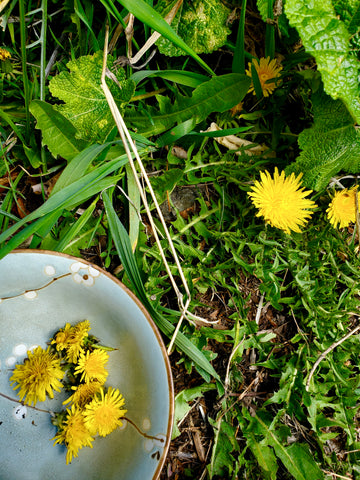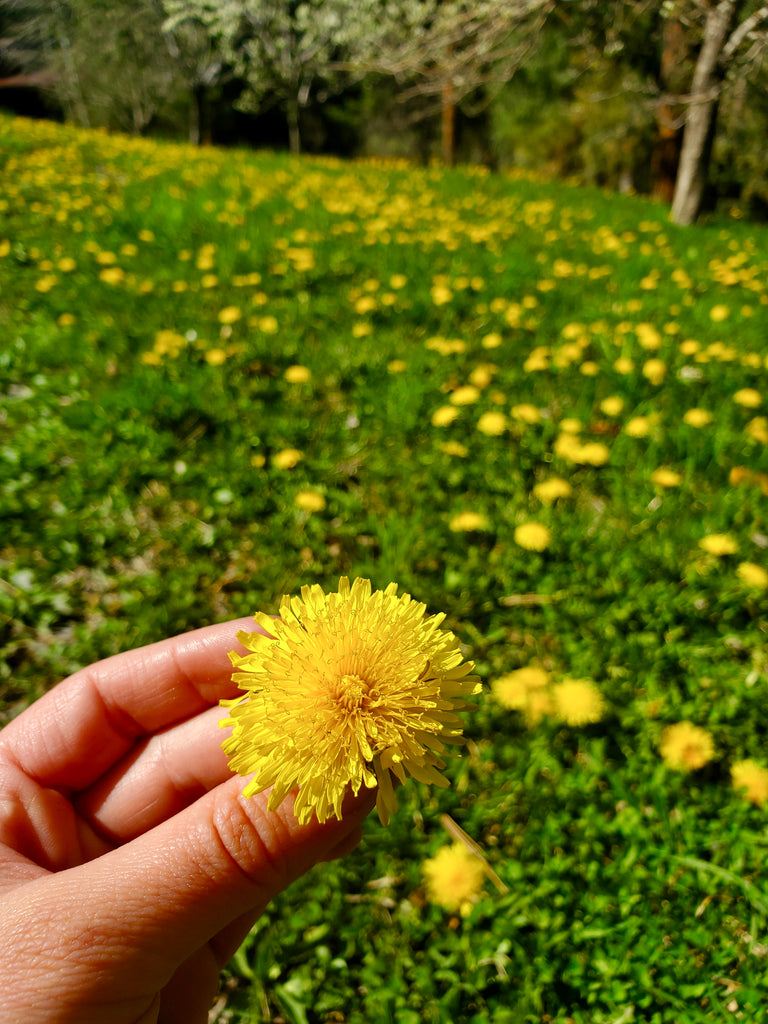Written by Elliott Brinkley, Clinical Herbalist & Owner of Dancing Willow Herbs
Aligned in the arts of the sun, calling it forth from winter’s chill, dandelion sings of warming days and color long forgotten. Wildly rooted and persistent, dandelion will creep into every facet of your yard, sidewalk, hillside with a smile as if entirely unaware of the war against her presence. If we softened our prejudice against this steadfast ally, we could recognize the gifts eager to be bestowed upon us all.
Sometimes I release my imagination to draw up characters that represent various flowers and plants. Dandelion is an activist, persistently fighting for what she feels is right. I envision her with thick golden curls, dressed in a rugged printed tee (no bra), holding a picketed sign with a bold lettered witty remark of protest. While she is passionately enraged by the state of the world, a smile continuously lifts her cheeks and squints her eyes in a symbol of tireless hope.
Dandelion teaches us resilience amidst trying conditions and circumstance. What medicine more symbolic could we be casting a chemical fight against?
She is not afraid of continuously returning to places where she has been shut out, unapologetically casting her rebellious gold in determination. Dandelion knows that she belongs, she is adaptable, and courageous in her efforts to be seen.
Bountiful gifts are laden in all parts of this plant. Dandelion wants to be seen right now for a reason, her message unique to each yet collective in nature. From the lore, medicine, and energetics, I invite you to deepen your relationship to this devoted plant teacher and ally.
Dandelion ~ Taraxacum officinalis

Family: Asteraceae
Parts used: Roots, Leaves + Flowers
Native to: Europe + Asia
Naturalized: Every continent except Antartica
Energetics: Cool, dry
Herbal actions: Hepatic, digestive, aperient, alterative, nutritive, cholagogue, diuretic
Identification
The basal leaves emerge in a rosette around the plant. The leaves are irregularly toothed and distinctly jagged, contributing to the plant’s French name “dent de lion” meaning lion’s tooth. The leaves are smooth and hairless. They can grow upward given appropriate circumstances, or they will grow close to the ground on a lawn where it is advantageous to avoid the mower’s blade. The stem of the flower is hollow and can be used as a flute (with some practice), or a straw. The flowers reflect the sun, as their golden orb opens when the sun reaches them and closes with significant shade or nighttime. What may look like the petals of the dandelion is actually hundreds of individual flowers that will mature to create the many seeds eager to take flight. Dandelions have a deep and fleshy central taproot, with other roots reaching out to the sides.
Environmental Exchange

Many are eager to eradicate dandelions from their lawns and gardens without understanding the vital role this plant has in healing the soil and the ecosystem. Dandelion’s deep taproot searches the depth of the soil to pull up minerals into the top of the soil and the plant. This taproot and the root network system aerate and mineralize the soil- loosening compact soil for earthworms to compost and other plants to grow. Dandelions are excellent allies for an orchard as they produce ethylene gas which assists in the ripening of fruit. Additionally, the flowers call forth the early bees that then continue to pollinate the orchard.
Dandelions offer their golden nectar to an extensive range of pollinators. When the first honey beehives were imported to North America, dandelion was intentionally planted to provide the bees with dependable early season pollen and nectar. Dandelions have become an important source of early season food for a variety of butterflies, bees, ladybugs and more.
Medicinal Qualities
Open almost any general medicinal herb book, and you will meet dandelion and her many pages of medicinal gifts. It is comical to believe that at one point, European settlers brought over dandelion seeds and planted them their gardens. While some believe they were planted to provide early spring nourishment and leafy greens, it is more widely accepted that they intentionally cultivated dandelion to be used in medicine. The old greek name for dandelion “Taraxos achos” means “disorder remedy” and eludes to the multifaceted capabilities of this dear plant.

While the various parts of the plant have different actions on the body, they are harmonious when used together. The roots have an affinity for the liver while the leaves work more directly on the kidneys, blood and urinary tract. All parts of the plant are beneficial for digestion and gentle cleansing.
The roots of dandelion reach deep into the Earth gathering medicine to be utilized by our bodies. The roots are high in iron, magnesium, phosphorus, calcium, chromium, niacin, potassium, sodium, vitamin A and more. They taste bitter and slightly sweet, providing deep nourishment to the liver and colon.
An age old liver tonic, Dandelion root cools excess heat. By supporting and reducing stagnation in the liver, this medicine is often used to address skin conditions such as eczema and acne. It is often used to lower cholesterol, balance blood sugar levels, and aid symptoms of gout.
When harvested in the fall, the roots contain 25% inulin which takes time to build up throughout the season. Inulin is an indigestible starch that feeds the beneficial bacterial in our gut, which aids in motility and a healthy microbiome. Dandelion root can help resolve constipation, and improve fat digestion and absorption.
The leaves and the roots are both very bitter, either or both can be used to aid in digestion when taken before meals. The bitter flavor stimulates the secretion of bile from the liver, signaling the release of enzymes, leading your mouth to water- getting your body ready to digest your food.

Dandelion leaves are a quintessential spring tonic, used to revitalize the body from any sluggishness accumulated over winter. The leaves purify the blood and carry toxins out of the body through the kidneys. The leaves are diuretic, used to relieve bloating, breast tenderness and other symptoms of water retention. The specific diuretic action provided by dandelion is unique in the way that it acts on both sides of the kidneys. Because the leaves are remarkably high in potassium and sodium, they lead your body to excrete fluids while retaining ample minerals and electrolytes that other diuretics usually deplete.
In addition to the extremely high levels of potassium, these leaves are high in an array of vitamins and minerals to revitalize your body. They can be incorporated into cooking, and are less bitter before the plant flowers. The leaves can also be used for mild urinary tract infections, particularly in combination with other antimicrobial herbs such as Uva Ursi, or soothing demulcents such as Cornsilk or Chickweed.
The golden beam of a dandelion bloom offers medicine for us to utilize internally and externally. Internally, the flowers are high in vitamin A and carotenoids like lutein. They support the lymphatic system and reduce systemic inflammation.
When infused into oil and used topically, dandelion flowers can be used to aid in circulation and lymphatic flow. This can be particularly helpful for swollen lymph glands, tender breasts, and other stagnant areas of pain or soreness. It can be used to heal scars, sun damage, and promote healthy skin cells.
Contraindications
The flowers should be avoided if you are sensitive to the Asteraceae family. Avoid if you have gallbladder or kidney issues, or if you are taking blood thinners or diuretics.
Harvesting Guidelines
Ensure you are harvesting from a location that is free from chemicals, or dog urine.
Harvest leaves in the spring by plucking them at the base of the plant (the plant will have the least amount of bitter compounds before it flowers).
Pluck off flowers from the stem and then trim the hollow stem down to the base of the plant, so it doesn’t need to keep putting energy into a stem without a flower. Discard or use the stem as a straw.
Harvest the roots with reverence and a trowel. If you leave a little piece of the root in the ground it will grow again next season.
Dandelion Preparations

At Dancing Willow Herbs, we make Dandelion tincture that you can purchase here!
Dandelion can be found in many of our herbal formulas- such as our tincture blends or teas. Find the comprehensive selection of products featuring this bountiful herb, here!
Of the many formulas featuring Dandelion, LVR Tonic may be my favorite for its nourishing focus that is well suited to almost anyone. LVR Tonic is perfect for spring-time daily cleansing, or for anyone who wants to support detoxification & regeneration of the liver in an effective and nourishing way. You can purchase LVR Tonic here!
Learn More
If you would like to learn more about spring seasonal herbs, like Dandelion, get access to our comprehensive online course- Herbs for Springtime!
If you feel like your body needs a reset from the long winter, this class is for you. With all of the tangible tools that you need to feel your very best this spring season, you will learn how to support your liver health & cleanse in a way that is safe and highly effective.
You will learn:
- Energetic themes & common ailments that arise during spring, such as allergies, hormonal issues, skin conditions, sluggishness & how to address them
- A unique perspective on detox that encourages nourishment, first and foremost
- How to know when the liver needs support
- How the process of detoxification happens: phase 1 & 2 liver detoxification
- How to support GI health for optimal detoxification
- Lifestyle practices for springtime & optimizing liver function
- The class of herbs called "alteratives" and why they are so good for spring
- Bitter herbs and foods for liver support
- Herbal antihistamines
- Liver protectant herbs
- The best herbal formulas to work with on a daily basis during the spring season
This class includes
- A 1 hour long produced video class
- 3 different PDFs on detailed course material, recipes for springtime & elaborate herbal monographs.
- Over 30 pages of PDF content
- Springtime herbal product bundle discount
*If you are interested getting everything you need for an easeful spring transition, check out our Springtime Herbal Class & Product Bundle. This is the complete, everything you need package for an easeful spring transition. With access to our Herbs for Springtime class, and our 3 most recommended spring seasonal products you will have the tools to start cleansing & easing into spring right away.

